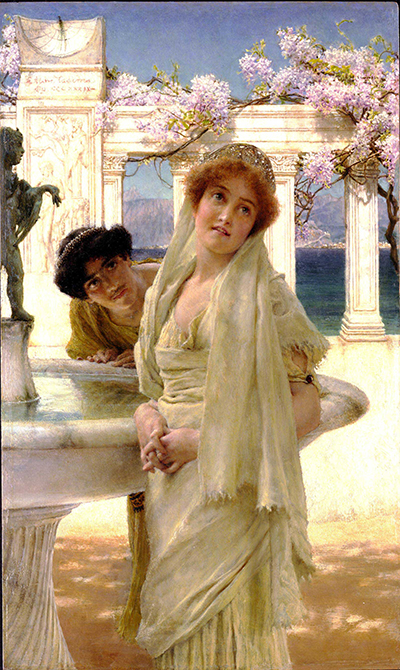Lawrence Alma-Tadema was born on January 8, 1836 and died on June 25, 1912. He was a famous Dutch painter who was raised in Dronrijp, in the Netherlands.
His artistic career began at the Royal Academy of Antwerp, that was located in Belgium. In 1870 he relocated to England, and stayed there until his death.
The painting style that he is most famed for is that of his depictions of Roman life and namely that of the Roman Empire.
He set his paintings in luxurious interiors that featured marble architecture and the Mediterranean Sea.
The Early Years
Lourens Alma Tadema gained his love of art from his mother who was an accomplished artist. She believed that all of her children should have art lessons and so Alma Tadema trained with a prestigious drawing master.
Although he became an accomplished artist himself, it was expected and assumed that he would become a lawyer.
This however was not to be as at the age of fifteen, in 1851, he sadly had a mental and physical breakdown, and was told that he only had a matter of months to live with a diagnosis of consumption. With lots of free leisure time, he carried on painting and drawing, perfecting his art, and he soon recovered to peruse his dream of becoming a professional artist.
Professional training
It was during 1852 that he enrolled at the Royal Academy of Antwerp located in Belgium. It was there that he studied the famous Flemish and Dutch artists, while under the watchful eye of Gustaf Wappers. He won many awards during his four years studying at the Academy.
It was in early 1859 that Alma-Tadema began to work with Baron Jan August Hendrik Leys, a painter whom he held in high esteem and who possessed the most prestigious art studio within Belgium. It was in this very studio that Alma-Tadema painted his first painting, The Education of the children of Clovis in 1861. From this moment on he became a painter whom everyone talked about. This particular painting was exhibited at the Artistic Congress within Antwerp and was well received by art critics and art enthusiasts. It was later gifted to the King of Belgium.
Personal life
Although his early works depicted the themes of romantic love, he very quickly switched to painting scenes of Greece and ancient Egypt. He researched his paintings in great detail. Indeed he became noted for his speciality in Ancient Greek art, but sadly in 1863 his mother died, and this would have a profound effect upon his artistry and personal life.
Earlier the same year, he married Marie-Pauline Gressin Dumoulin, the daughter of a French journalist. It was only six years later that she died, and very little is known about their early relationship, as Alma-Tadema was an incredibly private person. He did though paint his wife on several occasions, the most famous being, My studio in 1867.
Works
It was during 1870 that Alma-Tadema moved to London. He felt that a move to the UK would be helpful to his career. It was here that he was finally able to settle once more and to call London his home.
It was while living in London that he proposed to Laura Epps, who was only eighteen at the time, and they eventually married in 1871. Laura was also an accomplished artist and she too appeared in many of Alma-Tadema's paintings. The most famous of these is The Women of Amphissa that he painted in 1887.
Alma-Tadema achieved huge artistic success while living in London. He was one of the most well paid and highly respected artists of his generation. During this period, his most famous painting was that of An Audience at Agrippa's that he painted in 1875. It was in 1879, that Alma-Tadema became a full member of the Academicianhis.
His most famous painting, The Roses of Heliogabalus painted in 1888, was based upon the life of Elagabalus, a Roman Emperor. This image depicts the Emperor suffocating his guests in an assumed orgy. Rose petals can be seen descending from the sky. In 1891 he painted An Earthly Paradise, in 1893 Unconscious Rivals, Spring in 1894 and The Baths of Caracalla in 1899. He painted landscapes, portraits, and even watercolours.
Artistic style
Alma-Tadema's paintings feature heavily the use of while marble against the brilliant blue of the Mediterranean Sea. He painted beautifully the reflective surface of the marble and metallic surfaces that he observed.
In fact, his use of marble within his paintings gained him the affectionate name of the 'marbellous artist. He was a perfectionist and he very accurately depicted architecture in his paintings.
He read many books on the subject and visited museums to make sure that his buildings and objects that he painted were indeed an accurate portrayal and a perfect composition of the original. Although not a symbolist painter, his work has been compared to many of the great symbolist painters based in Europe, including Fernand Khnopff and Gustav Klimt.
The Later Years
During his later years, Alma-Tadema produced less work. This was due to a combination of decorating his newly acquired home and of ill health. He still continued to exhibit his art during the 1880s and was awarded the Honour at the Paris Exposition as well as becoming an honorary scholar of Oxford University.
He also received a Knighthood in 1899. It was also during his later years that he focussed more upon architecture and that of theatre design. He helped to design furniture for theatrical productions based upon Egyptian styles and textiles.
Sadly his second wife, Laura, died in 1909. She was fifty-seven. Alma-Tadema was overcome with grief and only lived for a further three years. He painted his last piece of art in 1912, Preparation in the Coliseum. It was also in this year that he sadly died, and was buried in St Paul's Cathedral, London.




